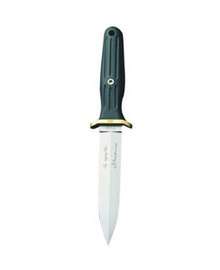Applegate–Fairbairn fighting knife
The Applegate–Fairbairn fighting knife is a combat knife designed by Colonel Rex Applegate and William E. Fairbairn as a version of the Fairbairn–Sykes fighting knife. The blade has a similar double-edged dagger profile, but is wider and more durable. It features a different handle, made most commonly of lexan plastic with adjustable lead weights which can change the knife's balance-point. Later models and some custom variants included weights made from pure Teflon, tungsten, stainless steel and aluminum. The blade profile was also changed from a V-grind to a convex, or "appleseed" profile. While this changed the overall effectiveness of the blade to puncture, cut and slice, it does not lend itself to be field sharpened by an inexperienced user.
| Applegate–Fairbairn fighting knife | |
|---|---|
 | |
| Type | Dagger |
| Place of origin | US |
| Service history | |
| In service | US |
| Used by | US |
| Production history | |
| Designer | William Ewart Fairbairn and Rex Applegate |
| Designed | 1941 |
| Manufacturer | Al Mar Knives, Blackjack Knives, Gerber Legendary Blades, Böker |
| Specifications | |
| Length | 11 inches (28 cm) |
| Blade length | 6 inches (15 cm) |
| Blade type | Dagger |
| Hilt type | lexan |
| Scabbard/sheath | leather |
| Head type | Metal |
| Haft type | Metal |
History
While Applegate was a student of Fairbairn, he came up with a series of modifications to Fairbairn's Dagger and worked with Fairbairn on implementing them. Applegate first approached Randall Made Knives with their design. Bo Randall made a handful of prototypes based on his "Model 2 Dagger" and sent them to soldiers for field testing; they proved not to be popular with the troops and Randall declined to produce the knife beyond the original prototypes.[1]
Applegate took the design to custom knifemaker Bill Harsey, Jr. who made several prototypes for Al Mar Knives.[2] In 1995, Harsey would design a folding version for Gerber Legendary Blades, which won the 1996 International Blade Show "American Made Knife of the Year" award.[3]
After Al Mar ceased production of the A–F fighting knife, a number of variations were made by Blackjack Knives, Gerber and Böker Knives, all with limited degrees of success.[2] The US Military Stock Number for the Gerber folding version is NSN: 5110-01-436-1548.
References
- Hunt, Robert E. (2002). Randall Fighting Knives in Wartime: WWII, Korea & Vietnam. Paducah, KY: Turner Publishing Company. p. 52. ISBN 978-1-56311-779-4.
- Walker, Greg (1993). Battle Blades: A Professional's Guide to Combat and Fighting Knives. Paladin Press. p. 17. ISBN 978-0-87364-732-8.
- Shackleford, Steve, Blade Magazine, “1996 Blade Magazine Knives of the Year”, October 1996, p. 16-20